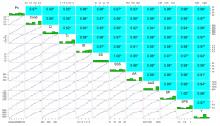
中国农学通报 ›› 2025, Vol. 41 ›› Issue (10): 18-24.doi: 10.11924/j.issn.1000-6850.casb2024-0447
齐泽鑫1( ), 关成龙1, 张梦如1, 王也1, 孙文正1, 张治安1, 包淑英2(
), 关成龙1, 张梦如1, 王也1, 孙文正1, 张治安1, 包淑英2( )
)
收稿日期:2024-07-09
修回日期:2024-12-18
出版日期:2025-04-05
发布日期:2025-04-03
通讯作者:
作者简介:齐泽鑫,男,1997年出生,吉林敦化人,博士,研究方向为作物栽培生理。通信地址:130118 长春市新城大街2888号 吉林农业大学农学院,Tel:0431-84532849,E-mail:20200023@mails.jlau.edu.cn。
基金资助:
QI Zexin1( ), GUAN Chenglong1, ZHANG Mengru1, WANG Ye1, SUN Wenzheng1, ZHANG Zhian1, BAO Shuying2(
), GUAN Chenglong1, ZHANG Mengru1, WANG Ye1, SUN Wenzheng1, ZHANG Zhian1, BAO Shuying2( )
)
Received:2024-07-09
Revised:2024-12-18
Published:2025-04-05
Online:2025-04-03
摘要:
为明确结荚后不同绿豆品种叶片光合、根系伤流特性及其与产量关系,以‘吉绿8号’、‘吉绿9号’、‘吉绿12号’、‘吉绿17号’和‘吉绿20号’5个吉林省主要种植的绿豆品种为材料,在绿豆产量形成的关键时期结荚期(R4期)测定叶片光合相关参数、根系伤流特性,在成熟期测定产量。结果表明,不同绿豆品种叶片光合、根系伤流特性和产量存在差异,‘吉绿12号’和‘吉绿9号’叶片的净光合速率、气孔导度、胞间二氧化碳浓度、蒸腾速率、根伤流液伤流强度、伤流液中可溶性蛋白含量及强度、可溶性糖含量及强度、游离氨基酸含量及强度、产量较高,显著高于‘吉绿8号’、‘吉绿17号’和‘吉绿20号’,其中‘吉绿12号’和‘吉绿9号’各指标之间的差异较小。绿豆的产量与叶片光合能力和根伤流中的组分及含量呈正相关关系。不同绿豆品种的产量与叶片光合和根伤流特性密切相关,叶片净光合速率和根伤流强度可作为选育高产绿豆品种的指标。
齐泽鑫, 关成龙, 张梦如, 王也, 孙文正, 张治安, 包淑英. 绿豆叶片光合、根系伤流特性及其与产量的关系[J]. 中国农学通报, 2025, 41(10): 18-24.
QI Zexin, GUAN Chenglong, ZHANG Mengru, WANG Ye, SUN Wenzheng, ZHANG Zhian, BAO Shuying. Photosynthetic and Root Bleeding Characteristics of Mung Bean Varieties and Their Relationship with Yield[J]. Chinese Agricultural Science Bulletin, 2025, 41(10): 18-24.


| [1] |
|
| [2] |
|
| [3] |
王珅, 范保杰, 刘长友, 等. 绿豆新品种产量及主要农艺性状鉴定与评价[J]. 作物杂志, 2024(3):90-99.
|
| [4] |
曲美霖, 胡俊君, 程哲, 等. 绿豆预熟化工艺及品质研究进展[J]. 食品与机械, 2024, 40(2):227-232.
|
| [5] |
|
| [6] |
|
| [7] |
|
| [8] |
|
| [9] |
|
| [10] |
|
| [11] |
|
| [12] |
|
| [13] |
|
| [14] |
郑殿峰, 赵黎明, 冯乃杰, 等. 植物生长调节剂对大豆根系同化物及内源激素代谢的影响[J]. 华北农学报, 2008(2):12-16.
doi: 10.7668/hbnxb.2008.02.003 |
| [15] |
|
| [16] |
耿明建, 朱建华, 吴礼树, 等. 不同硼效率棉花品种根系参数和伤流液组分的差异[J]. 土壤通报, 2006(4):744-747.
|
| [17] |
陈展宇, 张治安. 植物生理学实验指导[M]. 北京: 中国农业出版社, 2021:100-116.
|
| [18] |
叶航, 廖建勇, 杨丹, 等. 利用光合特性初步筛选耐弱光油茶品种[J]. 广西林业科学, 2012, 41(4):323-326.
|
| [19] |
陈军, 蔡金峰. 高光合速率与高叶绿素含量薄壳山核桃种质筛选[J]. 江苏农业科学, 2021, 49(19):164-167.
|
| [20] |
doi: 10.1016/j.copbio.2011.12.012 pmid: 22296828 |
| [21] |
高小丽, 孙健敏, 高金锋, 等. 不同基因型绿豆叶片光合性能研究[J]. 作物学报, 2007(7):1154-1161.
|
| [22] |
申慧芳, 郭锋. 不同基因型绿豆光合特性分析[J]. 山西农业科学, 2021, 49(11):1274-1279.
|
| [23] |
徐晨, 李鑫, 刘晓龙, 等. 不同滴灌方式对玉米根系伤流与光合特性的影响[J]. 核农学报, 2023, 37(10):2042-2051.
doi: 10.11869/j.issn.1000-8551.2023.10.2042 |
| [24] |
赵全志, 吕德彬, 程西永, 等. 杂种小麦群体光合速率及伤流强度优势研究[J]. 中国农业科学, 2002(8):925-928.
|
| [25] |
张玉姣, 徐克章, 陈展宇, 等. 不同年代大豆品种根系伤流液含氮化合物的变化[J]. 中国油料作物学报, 2014, 36(4):469-475.
doi: 10.7505/j.issn.1007-9084.2014.04.006 |
| [26] |
邓宏中, 李鑫, 徐克章, 等. 不同年代大豆品种根系伤流液中可溶性糖含量的变化及与叶片光合的关系[J]. 华南农业大学学报, 2013, 34(2):197-202.
|
| [27] |
孙庆泉, 胡昌浩, 董树亭, 等. 我国不同年代玉米品种生育全程根系特性演化的研究[J]. 作物学报, 2003(5):641-645.
|
| [28] |
刘胜群, 张天柱, 闫璇铃, 等. 不同耐旱基因型玉米伤流及其伤流液中碳、氮代谢相关成分含量分析[J]. 土壤与作物, 2012, 1(1):10-14.
|
| [29] |
|
| [30] |
李松雪. 不同绿豆品种叶片净光合速率、抗氧化酶活性及其与产量关系[D]. 长春: 吉林农业大学, 2020.
|
| [1] | 李阳阳, 陈帅民, 徐铭鸿, 迟畅, 马巍, 王胤平, 宋艳, 范作伟, 吴海燕. 腐解菌剂耦合尿素对水稻秸秆腐解率及产量的影响[J]. 中国农学通报, 2025, 41(9): 18-24. |
| [2] | 田翠玲, 田家良. 不同生育期喷施海藻酸增效液对冬小麦光合特性及产量的影响[J]. 中国农学通报, 2025, 41(9): 25-31. |
| [3] | 汪宝卿, 解备涛, 张立明. 不同耐旱性甘薯根系的转录组分析[J]. 中国农学通报, 2025, 41(9): 47-55. |
| [4] | 黄文茵, 张白鸽, 常静静, 陈潇, 李静, 陈雷, 赵俊宏, 罗谋雄, 宋钊. 外源肌醇对盐胁迫下番茄产量和品质的影响[J]. 中国农学通报, 2025, 41(9): 73-80. |
| [5] | 汪峰, 朱诗君, 应虹, 柴伟纲, 戴瑶璐, 袁晴, 金树权. 有机改良剂配合适度深耕对丘陵复垦稻田生产力提升效果[J]. 中国农学通报, 2025, 41(9): 91-98. |
| [6] | 王俊江, 尹媛红, 陆楚盛, 陆展华, 蔡昊炀, 叶群欢, 廖嘉晖, 卢钰升, 梁开明, 傅友强. 水稻关键生育期灌溉对干旱胁迫下稻谷产量和水分利用效率的影响[J]. 中国农学通报, 2025, 41(8): 1-10. |
| [7] | 李林, 晏云, 亢江飞, 孟琦翰, 方社法, 陈颖民, 郭建秋. 播期和密度对‘洛豆1304’生育进程、光合特性、农艺性状、产量及品质的影响[J]. 中国农学通报, 2025, 41(8): 11-18. |
| [8] | 薛远赛, 王锡久, 邹士国, 张守福, 刘光亚, 韩伟, 孙显. 复合寡糖对山东典型作物产量的影响[J]. 中国农学通报, 2025, 41(8): 50-56. |
| [9] | 马卓, 周韩冰, 赵满兴, 张霞, 王欣, 马丹妮. 黄腐酸钾对延安山地苹果养分吸收、产量及品质的影响[J]. 中国农学通报, 2025, 41(8): 63-68. |
| [10] | 王成, 李国瑞, 狄建军, 罗蕊, 李明静, 黄凤兰. 蓖麻菌酶生物肥对樱桃番茄生长、产量及品质的影响[J]. 中国农学通报, 2025, 41(8): 69-75. |
| [11] | 王鑫, 张欣欣, 米明, 李硕, 李好健, 马海林, 司东霞. 一次性施用氮肥对芍药生长及光合特性的影响[J]. 中国农学通报, 2025, 41(7): 61-66. |
| [12] | 苏丹, 王子诚, 贾俊英, 孙德智, 李志军, 郭园, 庄得凤. 水分调控对北苍术生长特性及药材产量品质的影响[J]. 中国农学通报, 2025, 41(7): 75-83. |
| [13] | 李梦寒, 胡文平, 董鑫, 普布桑珠, 宗巴吉. 种植密度和收获时期对林芝市粮饲通用型玉米产量的影响[J]. 中国农学通报, 2025, 41(7): 9-14. |
| [14] | 李腊平, 李效珍, 杨淑华, 岳新丽, 孙梦霞, 杨春仓. 防草布应用对大同黄花生长、发育及产量的影响研究[J]. 中国农学通报, 2025, 41(7): 107-114. |
| [15] | 赵娜, 李国清, 李国瑜, 丛新军, 张继波, 徐慧媛. 绿肥轮作对谷子农艺性状、产量及土壤养分的影响[J]. 中国农学通报, 2025, 41(7): 15-21. |
| 阅读次数 | ||||||
|
全文 |
|
|||||
|
摘要 |
|
|||||